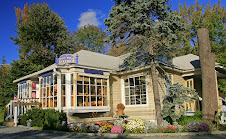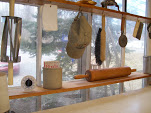When I started out in the bakery business the doughs that took the longest to ferment got mixed first, and, counter intuitively, they were all ready for make up at the same time. I hate being disorganized. It means ruined bread and chaotic scurrying about trying to get the loaves retarded before the doughs get old.
So I sat me down and concentrated on the problem, figuring that mixing the doughs from the shortest to the longest fermentation times was the answer, except for the doughs that took extreme amounts of time, say, three or more hours to ferment. They needed to be mixed first. The system works very well for the most part, but I needed to be certain of my ferment times, and the only way to guarantee a ferment time is to guarantee the dough temperature, and that requires a little calculation.
Once the optimum dough temperature is determined, 73f for sourdough say, the formula is simple. The finished dough temp is an average of it's ingredients, the air temperature, and the added heat of friction from kneading. (On most mixers the friction heat is one degree per minute of kneading.)
OK. We take 73 (the desired final temp of my sourdough) and subtract the mixer friction (13 minutes= 13 degrees). The result is 60. So, all of the main ingredients plus the air temp must have a combined average of 60 degrees. It is now a matter of determining how many components we are averaging, and in the case of my sourdough there are four: air, flour, starter and water, each with an arbitrary value of 60 (the desired average temp). We multiply 4 ingredients by 60 degrees and the result is 240.
Obviously, the ingredients will not all be the same temperature. I refrigerate my sour starter before using it. If the flour was just pulled from the stockroom and dumped in the bin it will not have the same temp as the air. And really, there is only one ingredient that can have it's temperature changed at will: water. All of this comes down to very simple arithmetic:
So I sat me down and concentrated on the problem, figuring that mixing the doughs from the shortest to the longest fermentation times was the answer, except for the doughs that took extreme amounts of time, say, three or more hours to ferment. They needed to be mixed first. The system works very well for the most part, but I needed to be certain of my ferment times, and the only way to guarantee a ferment time is to guarantee the dough temperature, and that requires a little calculation.
Once the optimum dough temperature is determined, 73f for sourdough say, the formula is simple. The finished dough temp is an average of it's ingredients, the air temperature, and the added heat of friction from kneading. (On most mixers the friction heat is one degree per minute of kneading.)
OK. We take 73 (the desired final temp of my sourdough) and subtract the mixer friction (13 minutes= 13 degrees). The result is 60. So, all of the main ingredients plus the air temp must have a combined average of 60 degrees. It is now a matter of determining how many components we are averaging, and in the case of my sourdough there are four: air, flour, starter and water, each with an arbitrary value of 60 (the desired average temp). We multiply 4 ingredients by 60 degrees and the result is 240.
Obviously, the ingredients will not all be the same temperature. I refrigerate my sour starter before using it. If the flour was just pulled from the stockroom and dumped in the bin it will not have the same temp as the air. And really, there is only one ingredient that can have it's temperature changed at will: water. All of this comes down to very simple arithmetic:
240
-Air temp
-Flour temp
-Starter temp
=Water temp
That would be, realistically:
240
-72f (air temp)
-69f (flour temp)
-40f (starter temp)
=59f (water temp)
I then mix the water to the proper temperature as it comes from the spigot using an instant-read thermometer as a gauge. The ferment time is 3 hrs. 30 min.
The desired temperature of my Italian bread is 80f. It gets mixed 16 minutes. 80 minus 16 is 64. The three main temperature considerations are air, flour and water. 64 (the average desired temp) times 3 (the number of factors) is 192. A realistic calculation would be:
192
-70f (air temp)
-69f (flour temp)
= 53f (water temp)
The ferment time is 2 hrs.
This works every time. Just remember that we are averaging main components only; minority ingredients such as salt or yeast are not included. You will need to experiment to find the optimum temperatures of your doughs, but this system will allow you yo do it with ease.

